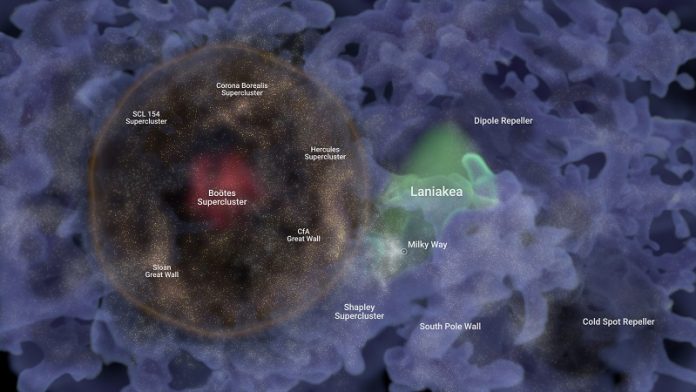
Guess what? Scientists have found a massive “bubble” in space that’s 820 million light-years away from Earth!
This incredible discovery could help us understand how the universe was born.
A team of astronomers led by Brent Tully from the University of Hawaiʻi stumbled upon this cosmic bubble while studying a big web of galaxies.
They named it Hoʻoleilana, a Hawaiian term that has to do with the origins of the universe. Cool, right?
The Big Bang theory suggests that the universe started with a big explosion. After that explosion, the material of the universe started moving around, creating waves or “ripples.”
These ripples are known as Baryon Acoustic Oscillations (BAO). And guess what? Hoʻoleilana seems to be one of those ancient ripples!
What’s extra surprising is the bubble’s size. It’s so big that it even spilled out of the area the scientists were studying.
“The size of this bubble is bigger than what our theories predicted,” Tully explained. “If our theories are right, then this discovery also suggests that the universe might be expanding faster than we thought.”
So how did they find it? They used data from a huge collection of galaxy distances known as Cosmicflows-4. This is the biggest list we have so far about how far away galaxies are from us.
Using this data, they were able to map the bubble in three dimensions. The map showed that the center of the bubble has a lot of galaxies, more than usual. This is a big hint that it’s not just a random collection but a structure formed long ago.
Daniel Pomarede, another researcher, was amazed to map out Hoʻoleilana. He mentioned that this bubble includes other big structures that astronomers had already found.
Compared to another supercluster of galaxies, called the Laniākea Supercluster, which includes our own Milky Way, Hoʻoleilana is much bigger.
Interestingly, this isn’t the first time Hoʻoleilana has been mentioned. It showed up in a 2016 study, but back then, researchers didn’t realize how big and important it was. With the new data, scientists could see it much clearer.
They found that Hoʻoleilana also contains many other well-known structures, like the Harvard/Smithsonian Great Wall and the Boötes Supercluster.
What does this all mean for us?
First, it helps scientists double-check the Big Bang theory. Second, Hoʻoleilana could hint that the universe is expanding faster than we thought. This might even change our current understanding of how the universe works.
The chances of Hoʻoleilana being just a random collection of galaxies are less than 1%, so it’s most likely an ancient “fossil” left behind from the birth of the universe.
To sum it up, the discovery of this gigantic cosmic bubble named Hoʻoleilana is like finding a treasure map to the universe’s past.
It has left astronomers super excited and curious about what other cosmic wonders await to be found!
The study was published in The Astrophysical Journal.
Follow us on Twitter for more articles about this topic.
Source: University of Hawaii at Manoa.



